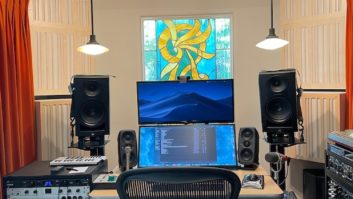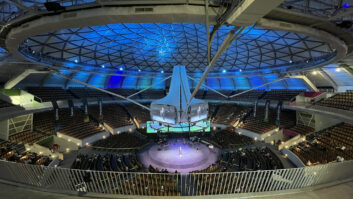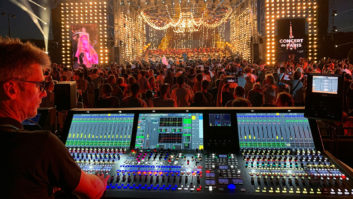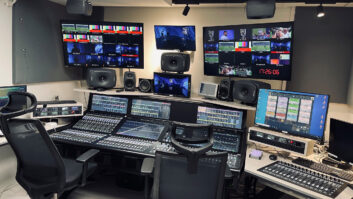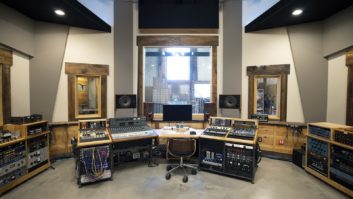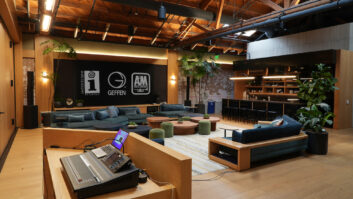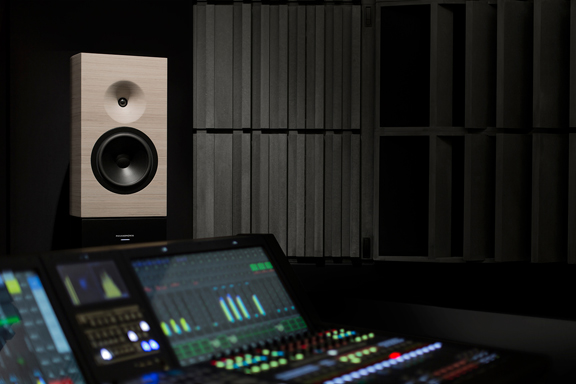
Paris, France – November 1, 2016 – Amadeus has announced the completion of a new install and acoustical design project for the Philharmonie de Paris concert hall studios. While Amadeus is well known as a high-end professional audio products designer and manufacturer for sound reinforcement systems and studio monitors, the Company also runs ‘Amadeus Labs‘, an acoustics-specialized research and consulting unit. Managed by acoustician Michel Deluc, co-founder and R&D Manager for Amadeus brands, Amadeus Labs recently re-designed both of the prestigious Philharmonie de Paris concert hall’s studio control rooms and their main monitoring system. Amadeus Labs collaborated with the studio’s sound engineers, while continuing to work alongside Jean Nouvel, the Philharmonie de Paris’ very own architect and designer. Amadeus Labs works with various customers, including mixing and mastering studios, composers, concert halls, research centres, and many other institutions, to create specialized acoustical environments, often also utilizing Amadeus speakers. Jean Nouvel co-designed the recently released Amadeus ‘Philharmonia’ speakers with Amadeus.
With its design, ergonomics and acoustics devised by Yasuhisa Toyota of Nagata Acoustics and Sir Harold Marshall from Marshall Day Acoustics, the Philharmonie de Paris is among the most unique symphonic halls in the world. Built to immortalize the performances of the world’s most prestigious symphonic orchestras, the Philharmonie de Paris mixing and mastering studios required a monitoring system of upmost transparency, placed in the highest-level optimized acoustic spaces.
Having acoustics and electro-acoustics match up is a basic premise of our design philosophy when designing and outfitting spaces dedicated to creation, mixing, mastering, postproduction or dubbing, or just high-level listening, among other tasks,” says Michel Deluc. “Our inclusive approach and dual expertise have made us able to create perfectly imagined spaces where the acoustical response has been perfected, ready to house the monitoring systems we design in parallel. We have many successes in the field of acoustical and/or electro-acoustical custom design.”
“The acoustics I design aggregate a lot of techniques I acquired, imagined and developed during the last 30 years for various complex spaces. This specific project required an acoustical response combining high clarity, great intimacy and depth, echoing the choices Yasuhisa Toyota and Sir Harold Marshall made for the Grande Salle,” adds Deluc.
The main Philharmonie de Paris rehearsal room hosts not only public orchestra rehearsals, but also pre-concert events, conferences and chamber music/amplified music concerts. The ‘Studio Salle de Répétition’ is equipped with a tailor-made acoustical treatment, very similar to the treatment used in the ‘Studio Grande Salle’. Each studio is equipped with a unique Surround monitoring system, made up of five Amadeus Philharmonia speakers, along with an Amadeus ‘ML 15 D’ subwoofer.
About the ‘Philharmonia’ speakers
Bernard Byk, Amadeus co-founder and CEO, describes the Company’s recently released Philharmonia speakers, “Imagine a reference sound system with exceptional design, ergonomics and acoustics, as a kind of consecration! Jean Nouvel’s imagination, exuberance and creative genius, combined with Michel Deluc’s engineering, brought a brilliant solution to life. Amadeus especially praises tradition, and the new speakers combine innovation as well as timeless beauty; christened ‘Philharmonia’, they embody the know-how, the creativity, and the values with which Amadeus has been building its history for more than 35 years.”
The Philharmonia features a curved structure that is both simple and complex, consisting of 547 wood veneers accurately machined and assembled, offering a distinctive look and volume. It features a unique hybrid laminar port using progressive termination. Michel Deluc reveals “The distinctive construction technique of Philharmonia helps neutralize standing waves affecting sonic clarity and low-frequency definition, through an extremely complex internal structure using a combination of interlocking panels arranged in two perpendicular planes, each hosting several tuned notch resonators.”
“This allows a dramatic decrease in sound coloration through a crossed structure of longitudinal and trans-verse reinforcements. This proprietary technique is in part inspired by Amadeus-designed professional Mains monitoring systems used in large recording studios, the ‘crossed structure’ itself drawing on aircraft manufacturing processes, particularly wing design,” continues Deluc.
As always, a huge part of speaker design is the components. “They have been carefully selected, evaluated, listened to, and combined,” Deluc explains. “The amplifier includes a built-in DSP module, with digital filtering functions such as system EQ, time alignment between HF and LF sections, limiter parameters, thermal protection of the transducers, and more.” He adds a personal note about the low-frequency port, “The aerodynamics of Philharmonia’s tuning ports is a masterpiece. It has been largely empirical, inspired by aesthetic aspects, and based on hybrid low-velocity laminar ports using progressive termination. This leads to a rather complex and major technological innovation, whose theory is still in its infancy.”
The new Philharmonia 2-way, self-powered speakers feature a 28-mm soft-dome tweeter and a custom 8-inch woofer, and boast analog and digital inputs with a customized integrated DAC and an amplitude linearity range (±2dB) from 43 Hz to 22 KHz. The high-frequency driver features very low dielectric losses and high thermal conductivity, loaded behind a fast exponential waveguide machined in wood, which yields exceptional control over spatial dispersion.
The cabinets are custom manufactured from layered Birch and stand 1.6 meters tall, the casing contains the electronics inside the lower part of the speaker enclosure. Each speaker is comprised of 547 wood veneers, accurately machined, aligned and glued, yielding a look that’s both simple and complex, and yet timeless. Each speaker features a unique hybrid laminar port using progressive termination for reproducing low frequencies. Machined into the wood material along the full height of the speaker system, the very low velocity port yields optimal linearity for the lowest possible distortion.
Philharmonia is bi-amplified using two dedicated very high resonance digital custom-built amplifiers, each amp delivers 700 Watts under 8 ohms. These proprietary PPM-PWM fixed frequency class-D amplifiers are equipped with a high-efficiency switched mode power supply. Each speaker channel is under control by a powerful, 64-bit digital processing unit capable of a 118 dB dynamic range. Each of these on-board DSP units include a module dedicated to managing core system parameters including system EQ, time alignment between sections, limiting, transducer thermal protection. This level of control makes Philharmonia fully protected and able to operate at the full extent of its abilities.
With line-level XLR analog input, Philharmonia lets users choose their own DAC, while at the same time, given that digital-to-analog conversion should happen at the latest possible stage in an electro-acoustical monitoring system, Philharmonia also integrates two digital inputs/outputs conforming to the AES3 digital audio data transfer standard. These are coupled with a high-resolution 24-bit/96kHz converter placed as close as possible to the electronic amplifiers, thus working together in perfect combination. The speakers also feature an RJ-45 network input allowing remote control of its DSP processor for optimal adjustment via dedicated software to match the speakers to the acoustical properties of each listening space. The software is an app that runs on Apple Macintosh and iPad, and Microsoft Windows computers.
Equipment included in the acoustic system developed by Amadeus Labs for the ‘Studio Grande Salle’:
* Amadeus Labs designed Helmholtz resonator, placed in front of the room, to control sub-bass frequencies
* Amadeus Labs designed diaphragm-based resonator, placed in front of the room, including two low-Q subsets [the first is tuned to 100Hz, the second to 56Hz].
* Dual Amadeus Labs designed hybrid diffusors, placed on the sides of the room, including three nested subsets (diaphragm-based resonator, wide range absorber, diffusor), treating the frequencies between 200Hz and 1000Hz.
* Three Amadeus Labs designed diaphragm-based resonators placed at the read of the room [two are tuned to 100Hz, the third to 84Hz].
* Two Amadeus Labs designed diaphragm-based resonator placed at the rear sides, tuned to 100Hz.
* Amadeus Labs designed hybrid diaphragm-based resonator including two superposed subsets (diaphragm-based resonator, mid-frequency absorber), treating the frequencies between 150Hz and 600Hz, is placed behind every Philharmonia monitor, to attenuate the residual energy emitted by their vent.
* Two diffusors placed on the sides of the room, treating the frequencies between 1500Hz and 6000Hz.
* Acoustically optimized furniture, with low acoustical footprint, hosting a ‘Lawo mc2 56’ digital mixing console.
For more information on the Philharmonie de Paris concert hall, visit: philharmoniedeparis.fr/en
For more information on the Amadeus Philharmonia speakers visit: www.philharmonia.paris
About Amadeus
Since more than twenty years, Amadeus develops, manufactures and sells a wide range of high-end sound reinforcement loudspeakers, studio monitors and high-end peripherals, allying high-level technologies, elegance and emotion. Created in 1992 from the meeting between French designer Bernard Byk and scientist Michel Deluc, Amadeus reputation grew and the brand became an essential reference for all audio professionals. A leading supplier of high-end audio solutions and services for theaters, opera houses, museums, recording studios, research centers and touring concert sound rental operations, Amadeus client list includes French customers like Institut de Recherche et Coordination Acoustique/Musique (IRCAM), Théâtre des Champs-Élysées, Théâtre National de Marseille, Opéra de Lyon, Philharmonie de Paris, Cité de la Musique, Gaîté Lyrique, and many more. All development and product manufacturing is centralized in Amadeus headquarters in France, with field offices and authorized distributors located in Europe, Asia and United Arab Emirates.
Contact Amadeus at [email protected] or visit www.amadeusaudio.fr
Amadeus is a registered trademark. All rights reserved. All other registered trademarks are property of their respective owners.
